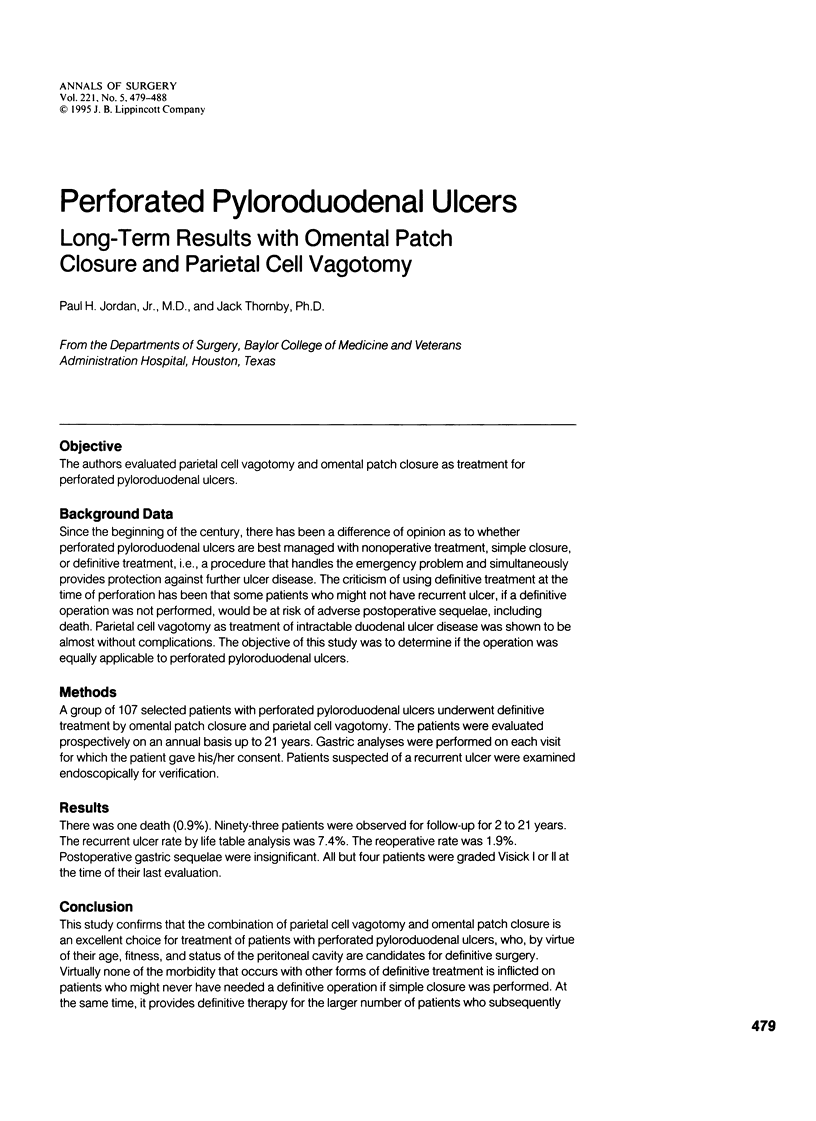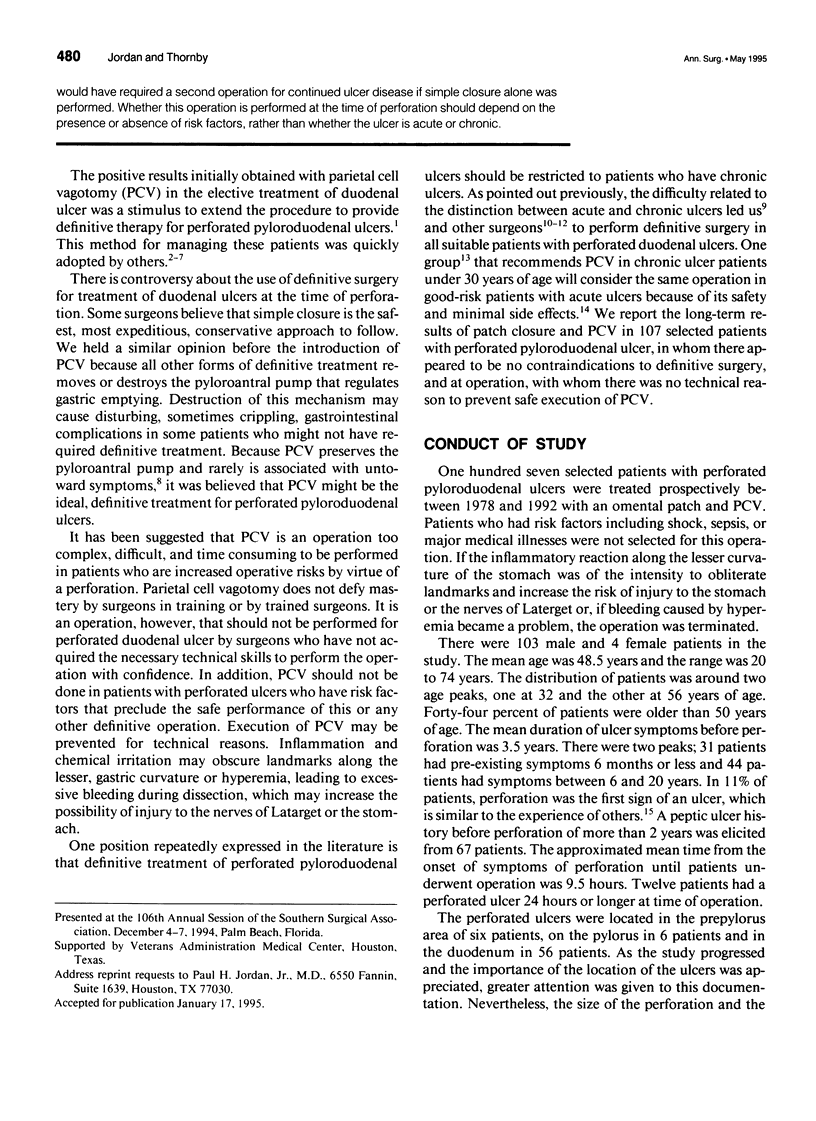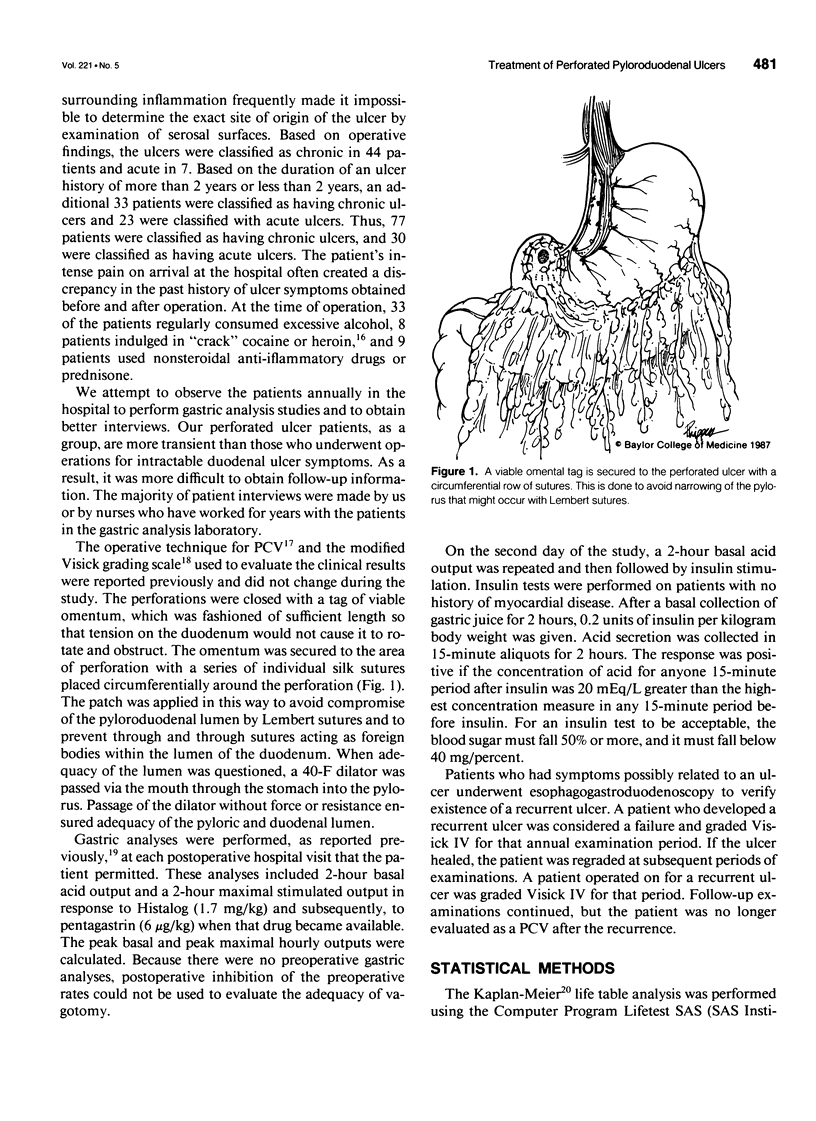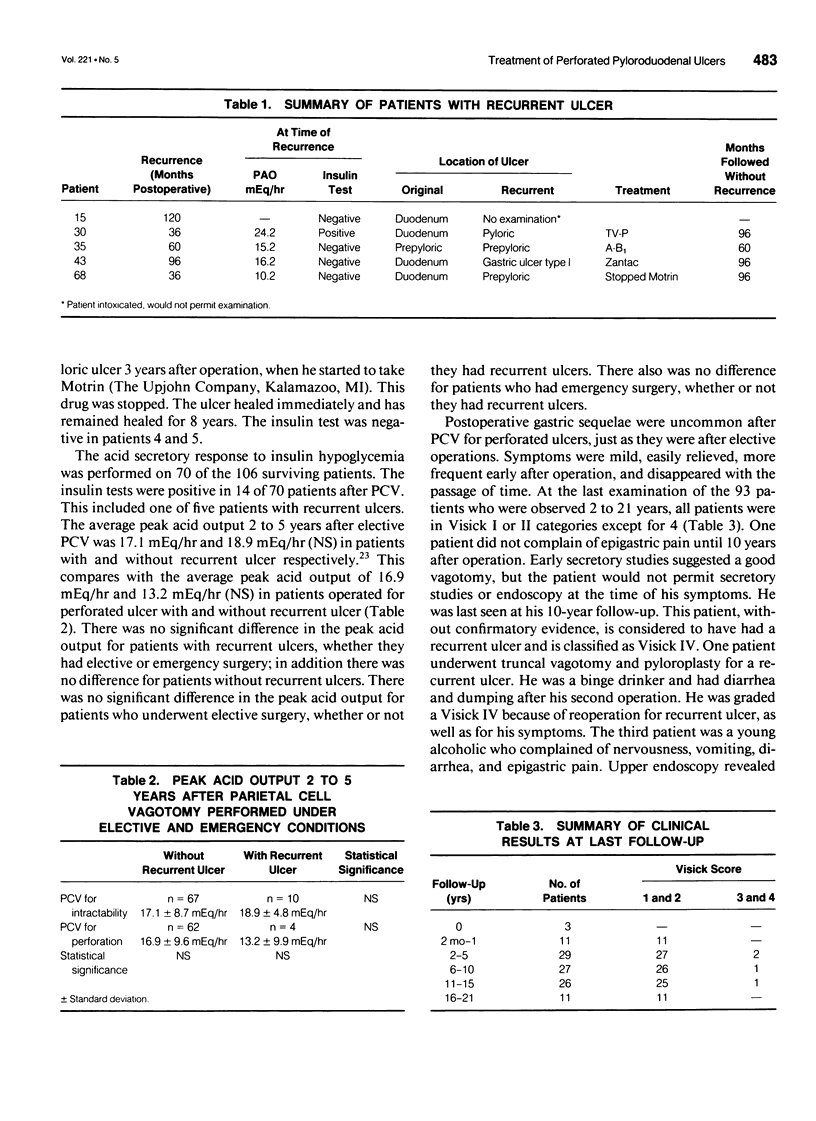Abstract
OBJECTIVE: The authors evaluated parietal cell vagotomy and omental patch closure as treatment for perforated pyloroduodenal ulcers. BACKGROUND DATA: Since the beginning of the century, there has been a difference of opinion as to whether perforated pyloroduodenal ulcers are best managed with nonoperative treatment, simple closure, or definitive treatment, i.e., a procedure that handles the emergency problem and simultaneously provides protection against further ulcer disease. The criticism of using definitive treatment at the time of perforation has been that some patients who might not have recurrent ulcer, if a definitive operation was not performed, would be at risk of adverse postoperative sequelae, including death. Parietal cell vagotomy as treatment of intractable duodenal ulcer disease was shown to be almost without complications. The objective of this study was to determine if the operation was equally applicable to perforated pyloroduodenal ulcers. METHODS: A group of 107 selected patients with perforated pyloroduodenal ulcers underwent definitive treatment by omental patch closure and parietal cell vagotomy. The patients were evaluated prospectively on an annual basis up to 21 years. Gastric analyses were performed on each visit for which the patient gave his/her consent. Patients suspected of a recurrent ulcer were examined endoscopically for verification. RESULTS: There was one death (0.9%). Ninety-three patients were observed for follow-up for 2 to 21 years. The recurrent ulcer rate by life table analysis was 7.4%. The reoperative rate was 1.9%. Postoperative gastric sequelae were insignificant. All but four patients were graded Visick I or II at the time of their last evaluation. CONCLUSION: This study confirms that the combination of parietal cell vagotomy and omental patch closure is an excellent choice for treatment of patients with perforated pyloroduodenal ulcers, who, by virtue of their age, fitness, and status of the peritoneal cavity are candidates for definitive surgery. Virtually none of the morbidity that occurs with other forms of definitive treatment is inflicted on patients who might never have needed a definitive operation if simple closure was performed. At the same time, it provides definitive therapy for the larger number of patients who subsequently would have required a second operation for continued ulcer disease if simple closure alone was performed. Whether this operation is performed at the time of perforation should depend on the presence or absence of risk factors, rather than whether the ulcer is acute or chronic.
Full text
PDF







Selected References
These references are in PubMed. This may not be the complete list of references from this article.
- Abramson D. L., Gertler J. P., Lewis T., Kral J. G. Crack-related perforated gastropyloric ulcer. J Clin Gastroenterol. 1991 Feb;13(1):17–19. doi: 10.1097/00004836-199102000-00006. [DOI] [PubMed] [Google Scholar]
- Agrez M. V., Henry D. A., Senthiselvan S., Duggan J. M. Changing trends in perforated peptic ulcer during the past 45 years. Aust N Z J Surg. 1992 Sep;62(9):729–732. doi: 10.1111/j.1445-2197.1992.tb07071.x. [DOI] [PubMed] [Google Scholar]
- Bodner B., Harrington M. E., Kim U. A multifactorial analysis of mortality and morbidity in perforated peptic ulcer disease. Surg Gynecol Obstet. 1990 Oct;171(4):315–320. [PubMed] [Google Scholar]
- Boey J., Choi S. K., Poon A., Alagaratnam T. T. Risk stratification in perforated duodenal ulcers. A prospective validation of predictive factors. Ann Surg. 1987 Jan;205(1):22–26. doi: 10.1097/00000658-198701000-00005. [DOI] [PMC free article] [PubMed] [Google Scholar]
- Boey J., Lee N. W., Koo J., Lam P. H., Wong J., Ong G. B. Immediate definitive surgery for perforated duodenal ulcers: a prospective controlled trial. Ann Surg. 1982 Sep;196(3):338–344. doi: 10.1097/00000658-198209000-00013. [DOI] [PMC free article] [PubMed] [Google Scholar]
- Boey J., Lee N. W., Wong J., Ong G. B. Perforations in acute duodenal ulcers. Surg Gynecol Obstet. 1982 Aug;155(2):193–196. [PubMed] [Google Scholar]
- Boey J., Wong J. Perforated duodenal ulcers. World J Surg. 1987 Jun;11(3):319–324. doi: 10.1007/BF01658109. [DOI] [PubMed] [Google Scholar]
- Ceneviva R., de Castro e Silva Júnior O., Castelfranchi P. L., Módena J. L., Santos R. F. Simple suture with or without proximal gastric vagotomy for perforated duodenal ulcer. Br J Surg. 1986 Jun;73(6):427–430. doi: 10.1002/bjs.1800730604. [DOI] [PubMed] [Google Scholar]
- Cheng T. O. Glimpses of the past from the recently unearthed ancient corpses in China. Ann Intern Med. 1984 Nov;101(5):714–715. doi: 10.7326/0003-4819-101-5-714. [DOI] [PubMed] [Google Scholar]
- Choi S., Boey J., Alagaratnam T. T., Poon A., Wong J. Proximal gastric vagotomy in emergency peptic ulcer perforation. Surg Gynecol Obstet. 1986 Dec;163(6):531–535. [PubMed] [Google Scholar]
- Collier D. S., Pain J. A. Non-steroidal anti-inflammatory drugs and peptic ulcer perforation. Gut. 1985 Apr;26(4):359–363. doi: 10.1136/gut.26.4.359. [DOI] [PMC free article] [PubMed] [Google Scholar]
- Debas H. T. Surgical management of peptic ulcer disease. J Assoc Acad Minor Phys. 1992;3(4):137–141. [PubMed] [Google Scholar]
- Donovan A. J., Vinson T. L., Maulsby G. O., Gewin J. R. Selective treatment of duodenal ulcer with perforation. Ann Surg. 1979 May;189(5):627–636. doi: 10.1097/00000658-197905000-00013. [DOI] [PMC free article] [PubMed] [Google Scholar]
- Feliciano D. V. Do perforated duodenal ulcers need an acid-decreasing surgical procedure now that omeprazole is available? Surg Clin North Am. 1992 Apr;72(2):369–380. doi: 10.1016/s0039-6109(16)45684-7. [DOI] [PubMed] [Google Scholar]
- HADFIELD J. I., WATKIN D. F. VAGOTOMY IN THE TREATMENT OF PERFORATED DUODENAL ULCER. Br Med J. 1964 Jul 4;2(5400):12–17. doi: 10.1136/bmj.2.5400.12. [DOI] [PMC free article] [PubMed] [Google Scholar]
- Johnston D., Lyndon P. J., Smith R. B., Humphrey C. S. Highly selective vagotomy without a drainage procedure in the treatment of haemorrhage, perforation, and pyloric stenosis due to peptic ulcer. Br J Surg. 1973 Oct;60(10):790–797. doi: 10.1002/bjs.1800601010. [DOI] [PubMed] [Google Scholar]
- Jordan G. L., Jr, DeBakey M. E., Duncan J. M., Jr Surgical management of perforated peptic ulcer. Ann Surg. 1974 May;179(5):628–633. doi: 10.1097/00000658-197405000-00015. [DOI] [PMC free article] [PubMed] [Google Scholar]
- Jordan P. H., Jr, Condon R. E. A prospective evaluation of vagotomy-pyloroplasty and vagotomy-antrectomy for treatment of duodenal ulcer. Ann Surg. 1970 Oct;172(4):547–563. doi: 10.1097/00000658-197010000-00003. [DOI] [PMC free article] [PubMed] [Google Scholar]
- Jordan P. H., Jr, Korompai F. L. Evolvement of a new treatment for perforated duodenal ulcer. Surg Gynecol Obstet. 1976 Mar;142(3):391–395. [PubMed] [Google Scholar]
- Jordan P. H., Jr Proceedings: Parietal cell vagotomy without drainage. Early evaluation of results in the treatment of duodenal ulcer. Arch Surg. 1974 Apr;108(4):434–441. doi: 10.1001/archsurg.1974.01350280040008. [DOI] [PubMed] [Google Scholar]
- Jordan P. H., Jr Proximal Gastric vagotomy without drainage for treatment of perforated duodenal ulcer. Gastroenterology. 1982 Jul;83(1 Pt 2):179–183. [PubMed] [Google Scholar]
- Jordan P. H., Jr Proximal Gastric vagotomy without drainage for treatment of perforated duodenal ulcer. Gastroenterology. 1982 Jul;83(1 Pt 2):179–183. [PubMed] [Google Scholar]
- Jordan P. H., Jr, Thornby J. Should it be parietal cell vagotomy or selective vagotomy-antrectomy for treatment of duodenal ulcer? A progress report. Ann Surg. 1987 May;205(5):572–590. doi: 10.1097/00000658-198705000-00017. [DOI] [PMC free article] [PubMed] [Google Scholar]
- Jordan P. H., Jr, Thornby J. Twenty years after parietal cell vagotomy or selective vagotomy antrectomy for treatment of duodenal ulcer. Final report. Ann Surg. 1994 Sep;220(3):283–296. doi: 10.1097/00000658-199409000-00005. [DOI] [PMC free article] [PubMed] [Google Scholar]
- Kang J. Y. Some observations on the epidemiology of peptic ulcer disease in Singapore. Singapore Med J. 1992 Oct;33(5):468–471. [PubMed] [Google Scholar]
- Kirkpatrick J. R., Bouwman D. L. A logical solution to the perforated ulcer controversy. Surg Gynecol Obstet. 1980 May;150(5):683–686. [PubMed] [Google Scholar]
- Koo J., Ngan Y. K., Lam S. K. Trends in hospital admission, perforation and mortality of peptic ulcer in Hong Kong from 1970 to 1980. Gastroenterology. 1983 Jun;84(6):1558–1562. [PubMed] [Google Scholar]
- Kurata J. H., Haile B. M., Elashoff J. D. Sex differences in peptic ulcer disease. Gastroenterology. 1985 Jan;88(1 Pt 1):96–100. doi: 10.1016/s0016-5085(85)80139-6. [DOI] [PubMed] [Google Scholar]
- Lam S. K., Byth K., Ng M. M., Hui W. M., Mcintosh J., Piper D. W. Perforated peptic ulcer in Hong Kong and New South Wales. J Gastroenterol Hepatol. 1992 Sep-Oct;7(5):508–511. doi: 10.1111/j.1440-1746.1992.tb01029.x. [DOI] [PubMed] [Google Scholar]
- McGuire H. H., Jr, Horsley J. S., 3rd Emergency operations for gastric and duodenal ulcers in high risk patients. Ann Surg. 1986 May;203(5):551–557. doi: 10.1097/00000658-198605000-00016. [DOI] [PMC free article] [PubMed] [Google Scholar]
- Negre J. Perforated ulcer in elderly people. Lancet. 1985 Nov 16;2(8464):1118–1119. doi: 10.1016/s0140-6736(85)90699-3. [DOI] [PubMed] [Google Scholar]
- Nemanich G. J., Nicoloff D. M. Perforated duodenal ulcer: long-term follow-up. Surgery. 1970 May;67(5):727–734. [PubMed] [Google Scholar]
- Rees J. R., Thorbjarnarson B. Perforated gastric ulcer. Am J Surg. 1973 Jul;126(1):93–97. doi: 10.1016/s0002-9610(73)80102-3. [DOI] [PubMed] [Google Scholar]
- Sawyers J. L., Herrington J. L., Jr Perforated duodenal ulcer managed by proximal gastric vagotomy and suture plication. Ann Surg. 1977 Jun;185(6):656–660. doi: 10.1097/00000658-197706000-00007. [DOI] [PMC free article] [PubMed] [Google Scholar]
- Susser M. Period effects, generation effects and age effects in peptic ulcer mortality. J Chronic Dis. 1982;35(1):29–40. doi: 10.1016/0021-9681(82)90027-3. [DOI] [PubMed] [Google Scholar]
- Tanphiphat C., Tanprayoon T., Na Thalang A. Surgical treatment of perforated duodenal ulcer: a prospective trial between simple closure and definitive surgery. Br J Surg. 1985 May;72(5):370–372. doi: 10.1002/bjs.1800720513. [DOI] [PubMed] [Google Scholar]
- Walt R., Katschinski B., Logan R., Ashley J., Langman M. Rising frequency of ulcer perforation in elderly people in the United Kingdom. Lancet. 1986 Mar 1;1(8479):489–492. doi: 10.1016/s0140-6736(86)92940-5. [DOI] [PubMed] [Google Scholar]
- Wara P., Kristensen E. S., Sørensen F. H., Boné J., Skovgaard S., Amdrup E. The value of parietal cell vagotomy compared to simple closure in a selective approach to perforated duodenal ulcer. Operative morbidity and recurrence rate. Acta Chir Scand. 1983;149(6):585–589. [PubMed] [Google Scholar]
- Watkins R. M., Dennison A. R., Collin J. What has happened to perforated peptic ulcer? Br J Surg. 1984 Oct;71(10):774–776. doi: 10.1002/bjs.1800711012. [DOI] [PubMed] [Google Scholar]


